Employee Turnover & Skill Retention: Variable Analysis & Critique
VerifiedAdded on 2023/06/14
|6
|1037
|318
Journal and Reflective Writing
AI Summary
This journal entry identifies and analyzes the variables in a study about employee turnover and skill retention within Australian organizations. It categorizes variables as dependent (employee turnover, skill retention) and independent (HRM practices, high-performance work systems, market features, training practices), explaining how each is defined and measured. The motivation for including these variables in the conceptual framework is discussed, highlighting the study's focus on organizational factors rather than individual worker characteristics. The assignment also considers the numerical measurement of these variables using ratio scales, and suggests the inclusion of demographic differences, such as gender, as potential factors influencing turnover rates. This analysis is based on a paper by Smith, Oczkowski, and Selby-Smith (2011) and provides a critique of the study's approach to understanding employee turnover and skill retention.
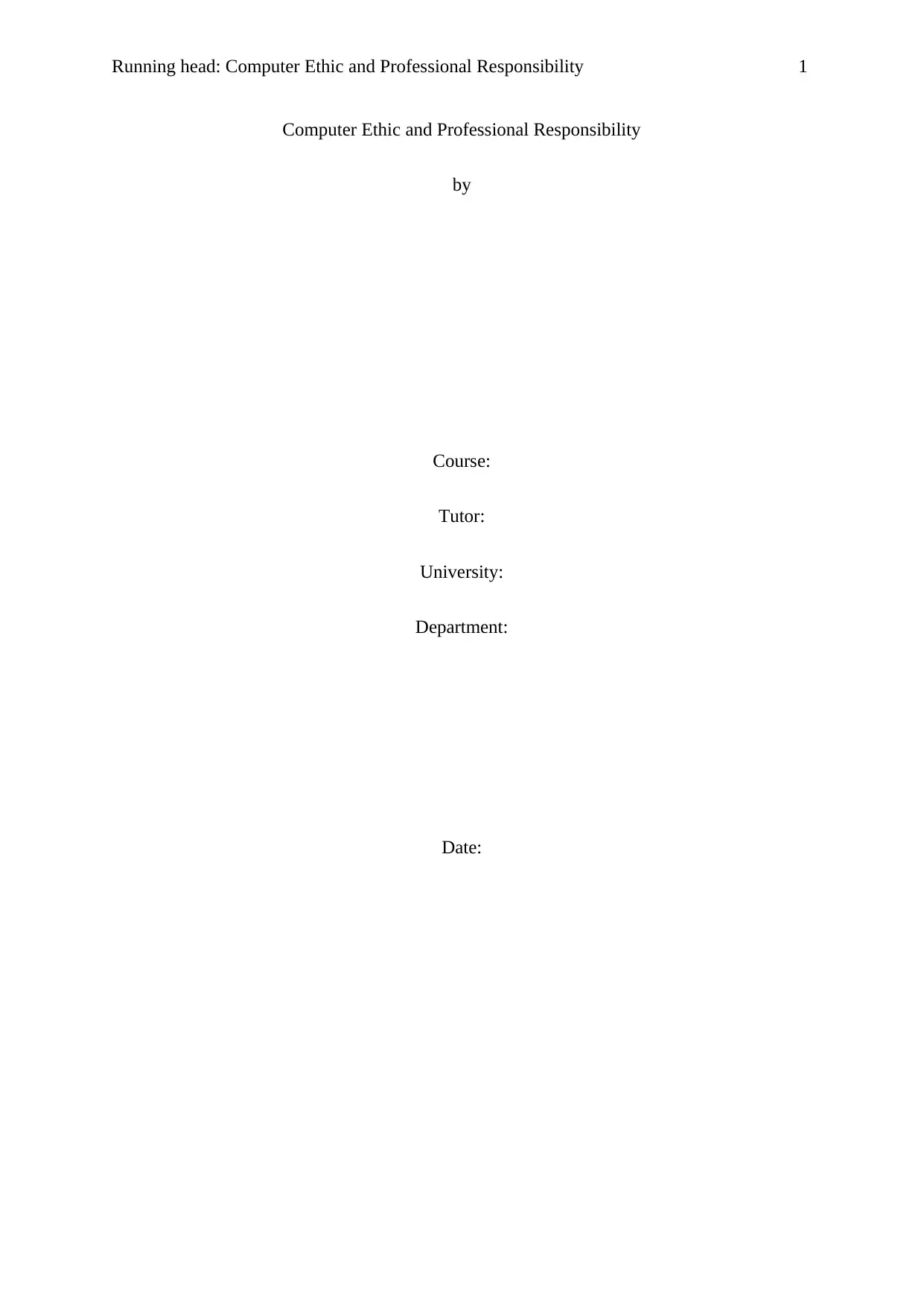
Running head: Computer Ethic and Professional Responsibility 1
Computer Ethic and Professional Responsibility
by
Course:
Tutor:
University:
Department:
Date:
Computer Ethic and Professional Responsibility
by
Course:
Tutor:
University:
Department:
Date:
Paraphrase This Document
Need a fresh take? Get an instant paraphrase of this document with our AI Paraphraser
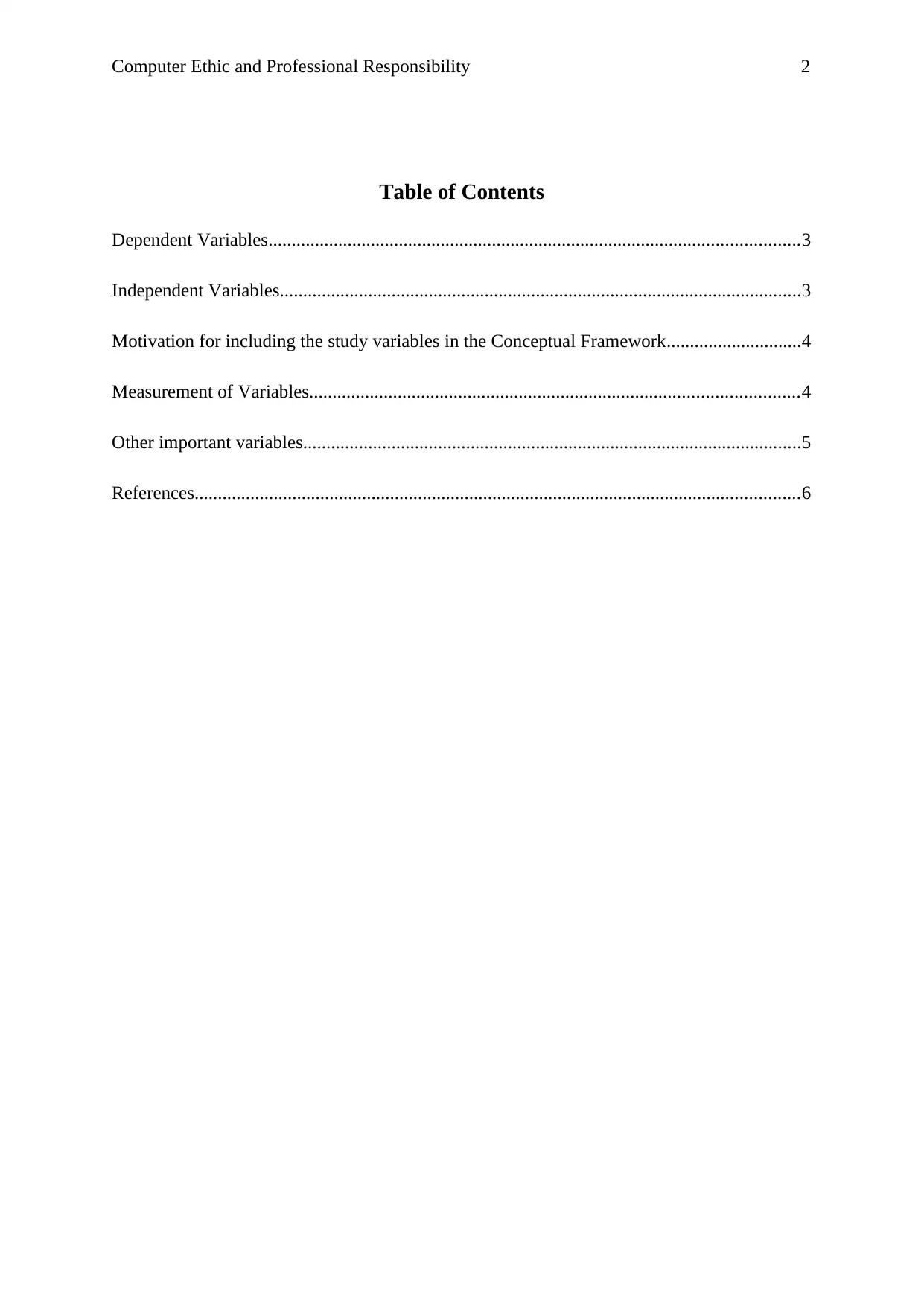
Computer Ethic and Professional Responsibility 2
Table of Contents
Dependent Variables..................................................................................................................3
Independent Variables................................................................................................................3
Motivation for including the study variables in the Conceptual Framework.............................4
Measurement of Variables.........................................................................................................4
Other important variables...........................................................................................................5
References..................................................................................................................................6
Table of Contents
Dependent Variables..................................................................................................................3
Independent Variables................................................................................................................3
Motivation for including the study variables in the Conceptual Framework.............................4
Measurement of Variables.........................................................................................................4
Other important variables...........................................................................................................5
References..................................................................................................................................6
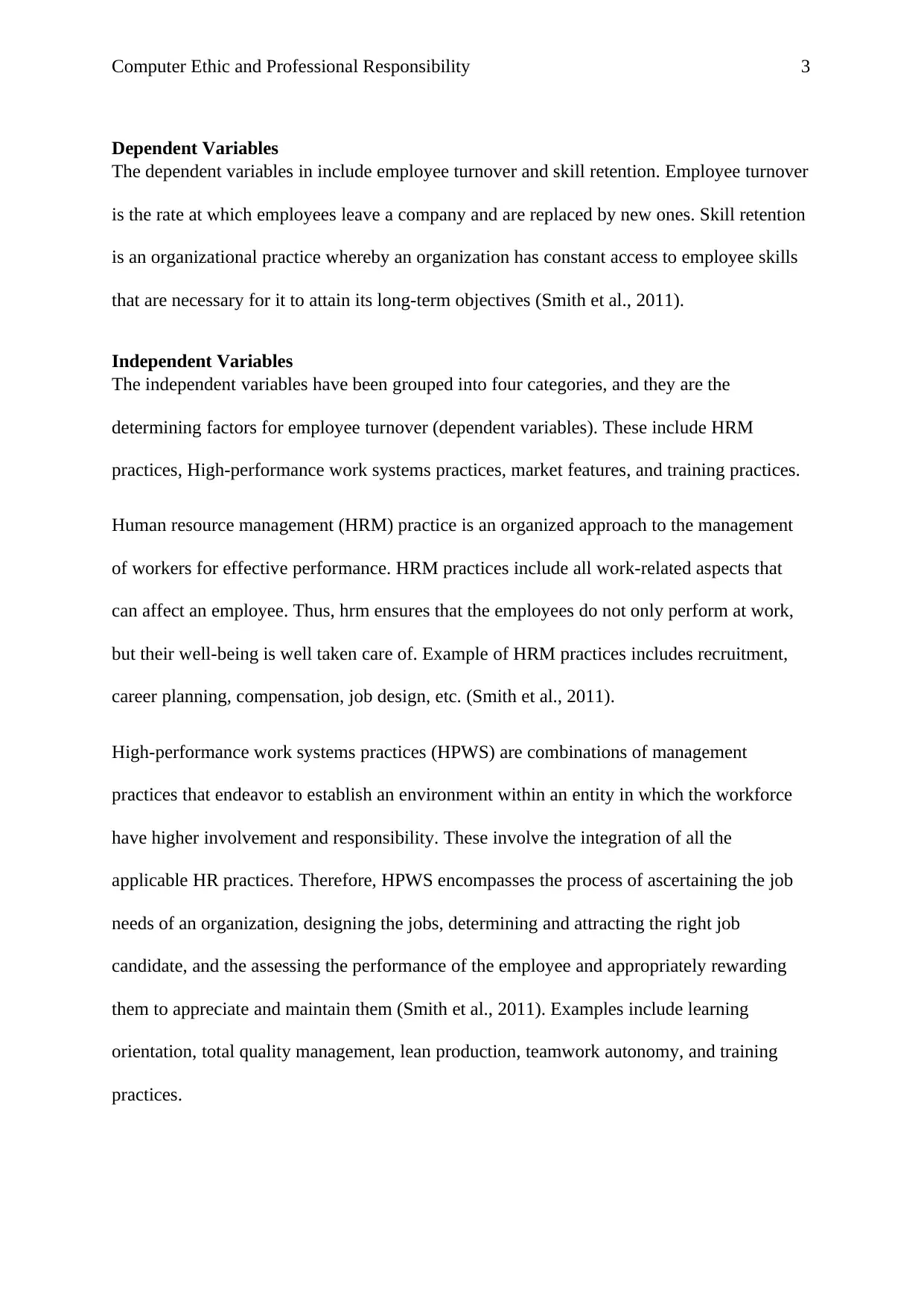
Computer Ethic and Professional Responsibility 3
Dependent Variables
The dependent variables in include employee turnover and skill retention. Employee turnover
is the rate at which employees leave a company and are replaced by new ones. Skill retention
is an organizational practice whereby an organization has constant access to employee skills
that are necessary for it to attain its long-term objectives (Smith et al., 2011).
Independent Variables
The independent variables have been grouped into four categories, and they are the
determining factors for employee turnover (dependent variables). These include HRM
practices, High-performance work systems practices, market features, and training practices.
Human resource management (HRM) practice is an organized approach to the management
of workers for effective performance. HRM practices include all work-related aspects that
can affect an employee. Thus, hrm ensures that the employees do not only perform at work,
but their well-being is well taken care of. Example of HRM practices includes recruitment,
career planning, compensation, job design, etc. (Smith et al., 2011).
High-performance work systems practices (HPWS) are combinations of management
practices that endeavor to establish an environment within an entity in which the workforce
have higher involvement and responsibility. These involve the integration of all the
applicable HR practices. Therefore, HPWS encompasses the process of ascertaining the job
needs of an organization, designing the jobs, determining and attracting the right job
candidate, and the assessing the performance of the employee and appropriately rewarding
them to appreciate and maintain them (Smith et al., 2011). Examples include learning
orientation, total quality management, lean production, teamwork autonomy, and training
practices.
Dependent Variables
The dependent variables in include employee turnover and skill retention. Employee turnover
is the rate at which employees leave a company and are replaced by new ones. Skill retention
is an organizational practice whereby an organization has constant access to employee skills
that are necessary for it to attain its long-term objectives (Smith et al., 2011).
Independent Variables
The independent variables have been grouped into four categories, and they are the
determining factors for employee turnover (dependent variables). These include HRM
practices, High-performance work systems practices, market features, and training practices.
Human resource management (HRM) practice is an organized approach to the management
of workers for effective performance. HRM practices include all work-related aspects that
can affect an employee. Thus, hrm ensures that the employees do not only perform at work,
but their well-being is well taken care of. Example of HRM practices includes recruitment,
career planning, compensation, job design, etc. (Smith et al., 2011).
High-performance work systems practices (HPWS) are combinations of management
practices that endeavor to establish an environment within an entity in which the workforce
have higher involvement and responsibility. These involve the integration of all the
applicable HR practices. Therefore, HPWS encompasses the process of ascertaining the job
needs of an organization, designing the jobs, determining and attracting the right job
candidate, and the assessing the performance of the employee and appropriately rewarding
them to appreciate and maintain them (Smith et al., 2011). Examples include learning
orientation, total quality management, lean production, teamwork autonomy, and training
practices.
⊘ This is a preview!⊘
Do you want full access?
Subscribe today to unlock all pages.

Trusted by 1+ million students worldwide
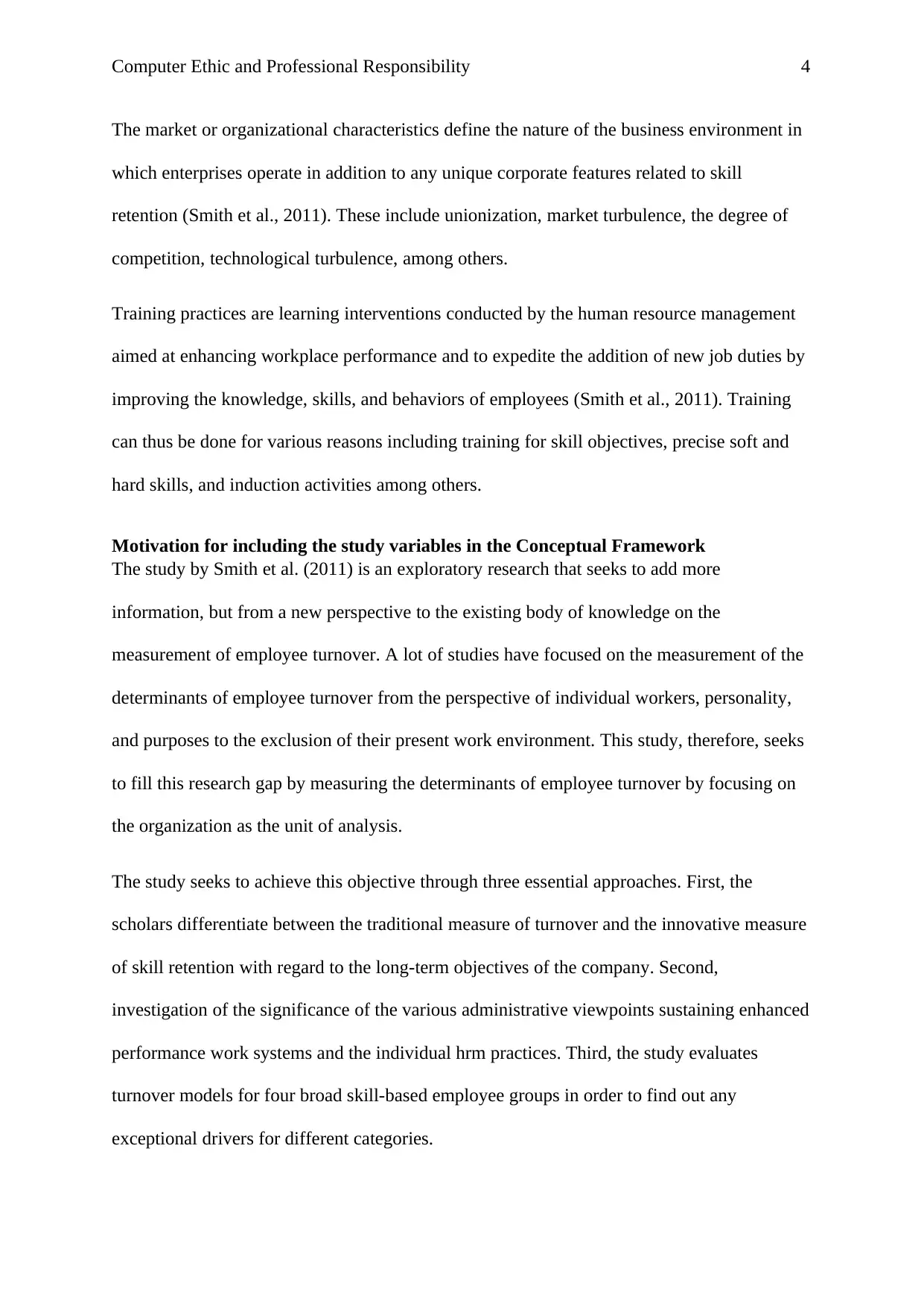
Computer Ethic and Professional Responsibility 4
The market or organizational characteristics define the nature of the business environment in
which enterprises operate in addition to any unique corporate features related to skill
retention (Smith et al., 2011). These include unionization, market turbulence, the degree of
competition, technological turbulence, among others.
Training practices are learning interventions conducted by the human resource management
aimed at enhancing workplace performance and to expedite the addition of new job duties by
improving the knowledge, skills, and behaviors of employees (Smith et al., 2011). Training
can thus be done for various reasons including training for skill objectives, precise soft and
hard skills, and induction activities among others.
Motivation for including the study variables in the Conceptual Framework
The study by Smith et al. (2011) is an exploratory research that seeks to add more
information, but from a new perspective to the existing body of knowledge on the
measurement of employee turnover. A lot of studies have focused on the measurement of the
determinants of employee turnover from the perspective of individual workers, personality,
and purposes to the exclusion of their present work environment. This study, therefore, seeks
to fill this research gap by measuring the determinants of employee turnover by focusing on
the organization as the unit of analysis.
The study seeks to achieve this objective through three essential approaches. First, the
scholars differentiate between the traditional measure of turnover and the innovative measure
of skill retention with regard to the long-term objectives of the company. Second,
investigation of the significance of the various administrative viewpoints sustaining enhanced
performance work systems and the individual hrm practices. Third, the study evaluates
turnover models for four broad skill-based employee groups in order to find out any
exceptional drivers for different categories.
The market or organizational characteristics define the nature of the business environment in
which enterprises operate in addition to any unique corporate features related to skill
retention (Smith et al., 2011). These include unionization, market turbulence, the degree of
competition, technological turbulence, among others.
Training practices are learning interventions conducted by the human resource management
aimed at enhancing workplace performance and to expedite the addition of new job duties by
improving the knowledge, skills, and behaviors of employees (Smith et al., 2011). Training
can thus be done for various reasons including training for skill objectives, precise soft and
hard skills, and induction activities among others.
Motivation for including the study variables in the Conceptual Framework
The study by Smith et al. (2011) is an exploratory research that seeks to add more
information, but from a new perspective to the existing body of knowledge on the
measurement of employee turnover. A lot of studies have focused on the measurement of the
determinants of employee turnover from the perspective of individual workers, personality,
and purposes to the exclusion of their present work environment. This study, therefore, seeks
to fill this research gap by measuring the determinants of employee turnover by focusing on
the organization as the unit of analysis.
The study seeks to achieve this objective through three essential approaches. First, the
scholars differentiate between the traditional measure of turnover and the innovative measure
of skill retention with regard to the long-term objectives of the company. Second,
investigation of the significance of the various administrative viewpoints sustaining enhanced
performance work systems and the individual hrm practices. Third, the study evaluates
turnover models for four broad skill-based employee groups in order to find out any
exceptional drivers for different categories.
Paraphrase This Document
Need a fresh take? Get an instant paraphrase of this document with our AI Paraphraser
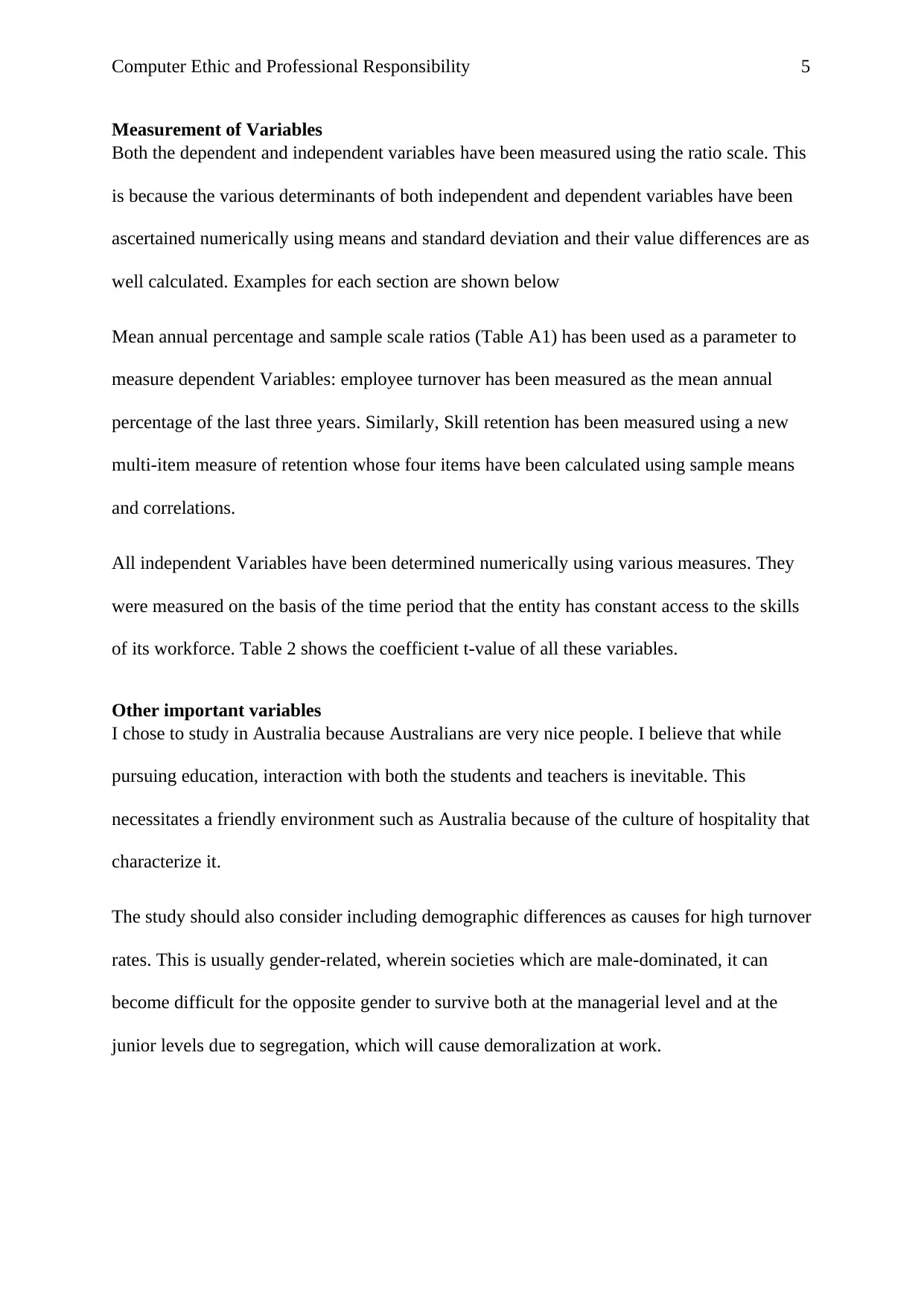
Computer Ethic and Professional Responsibility 5
Measurement of Variables
Both the dependent and independent variables have been measured using the ratio scale. This
is because the various determinants of both independent and dependent variables have been
ascertained numerically using means and standard deviation and their value differences are as
well calculated. Examples for each section are shown below
Mean annual percentage and sample scale ratios (Table A1) has been used as a parameter to
measure dependent Variables: employee turnover has been measured as the mean annual
percentage of the last three years. Similarly, Skill retention has been measured using a new
multi-item measure of retention whose four items have been calculated using sample means
and correlations.
All independent Variables have been determined numerically using various measures. They
were measured on the basis of the time period that the entity has constant access to the skills
of its workforce. Table 2 shows the coefficient t-value of all these variables.
Other important variables
I chose to study in Australia because Australians are very nice people. I believe that while
pursuing education, interaction with both the students and teachers is inevitable. This
necessitates a friendly environment such as Australia because of the culture of hospitality that
characterize it.
The study should also consider including demographic differences as causes for high turnover
rates. This is usually gender-related, wherein societies which are male-dominated, it can
become difficult for the opposite gender to survive both at the managerial level and at the
junior levels due to segregation, which will cause demoralization at work.
Measurement of Variables
Both the dependent and independent variables have been measured using the ratio scale. This
is because the various determinants of both independent and dependent variables have been
ascertained numerically using means and standard deviation and their value differences are as
well calculated. Examples for each section are shown below
Mean annual percentage and sample scale ratios (Table A1) has been used as a parameter to
measure dependent Variables: employee turnover has been measured as the mean annual
percentage of the last three years. Similarly, Skill retention has been measured using a new
multi-item measure of retention whose four items have been calculated using sample means
and correlations.
All independent Variables have been determined numerically using various measures. They
were measured on the basis of the time period that the entity has constant access to the skills
of its workforce. Table 2 shows the coefficient t-value of all these variables.
Other important variables
I chose to study in Australia because Australians are very nice people. I believe that while
pursuing education, interaction with both the students and teachers is inevitable. This
necessitates a friendly environment such as Australia because of the culture of hospitality that
characterize it.
The study should also consider including demographic differences as causes for high turnover
rates. This is usually gender-related, wherein societies which are male-dominated, it can
become difficult for the opposite gender to survive both at the managerial level and at the
junior levels due to segregation, which will cause demoralization at work.
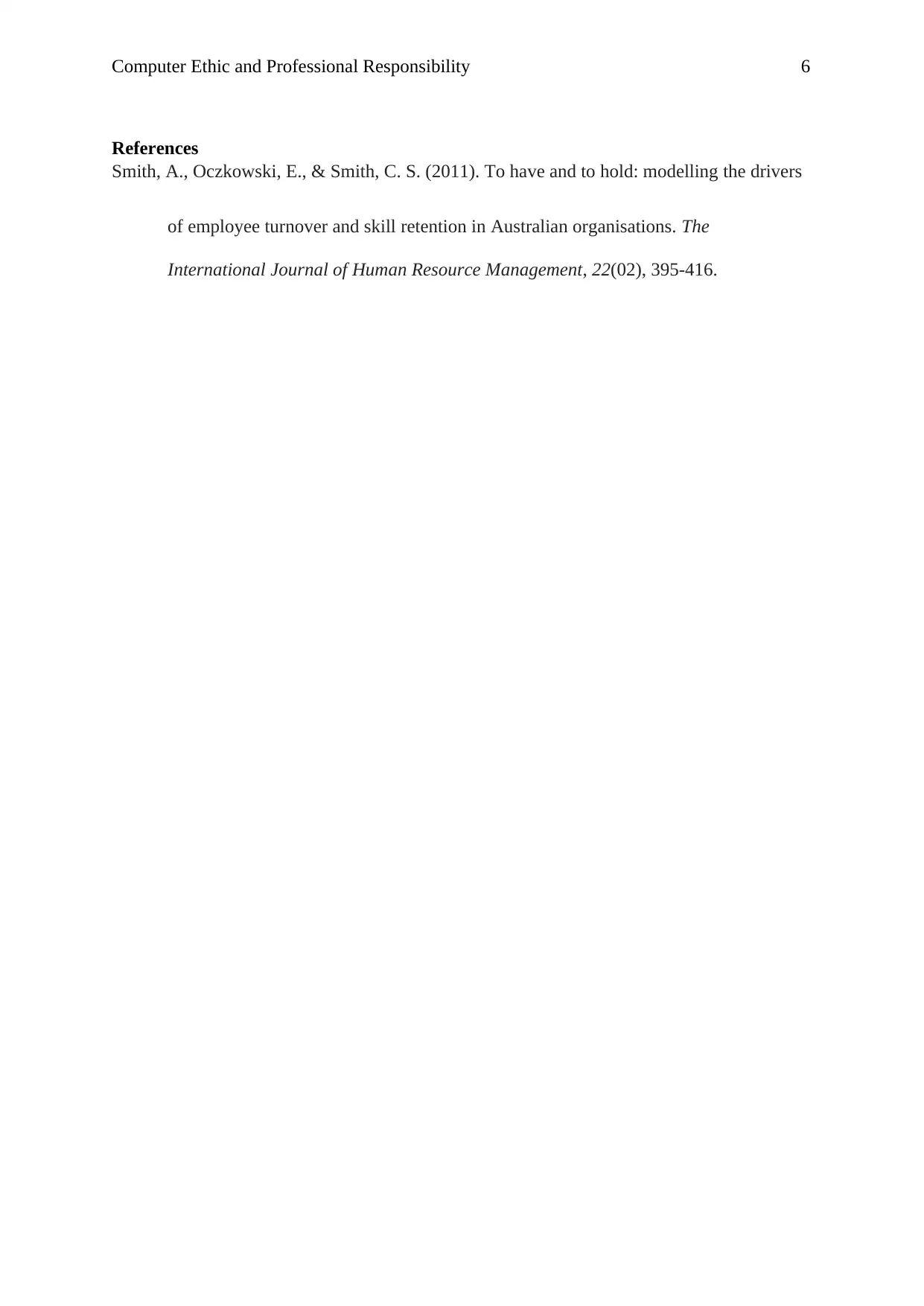
Computer Ethic and Professional Responsibility 6
References
Smith, A., Oczkowski, E., & Smith, C. S. (2011). To have and to hold: modelling the drivers
of employee turnover and skill retention in Australian organisations. The
International Journal of Human Resource Management, 22(02), 395-416.
References
Smith, A., Oczkowski, E., & Smith, C. S. (2011). To have and to hold: modelling the drivers
of employee turnover and skill retention in Australian organisations. The
International Journal of Human Resource Management, 22(02), 395-416.
⊘ This is a preview!⊘
Do you want full access?
Subscribe today to unlock all pages.

Trusted by 1+ million students worldwide
1 out of 6
Related Documents
Your All-in-One AI-Powered Toolkit for Academic Success.
+13062052269
info@desklib.com
Available 24*7 on WhatsApp / Email
![[object Object]](/_next/static/media/star-bottom.7253800d.svg)
Unlock your academic potential
Copyright © 2020–2025 A2Z Services. All Rights Reserved. Developed and managed by ZUCOL.





